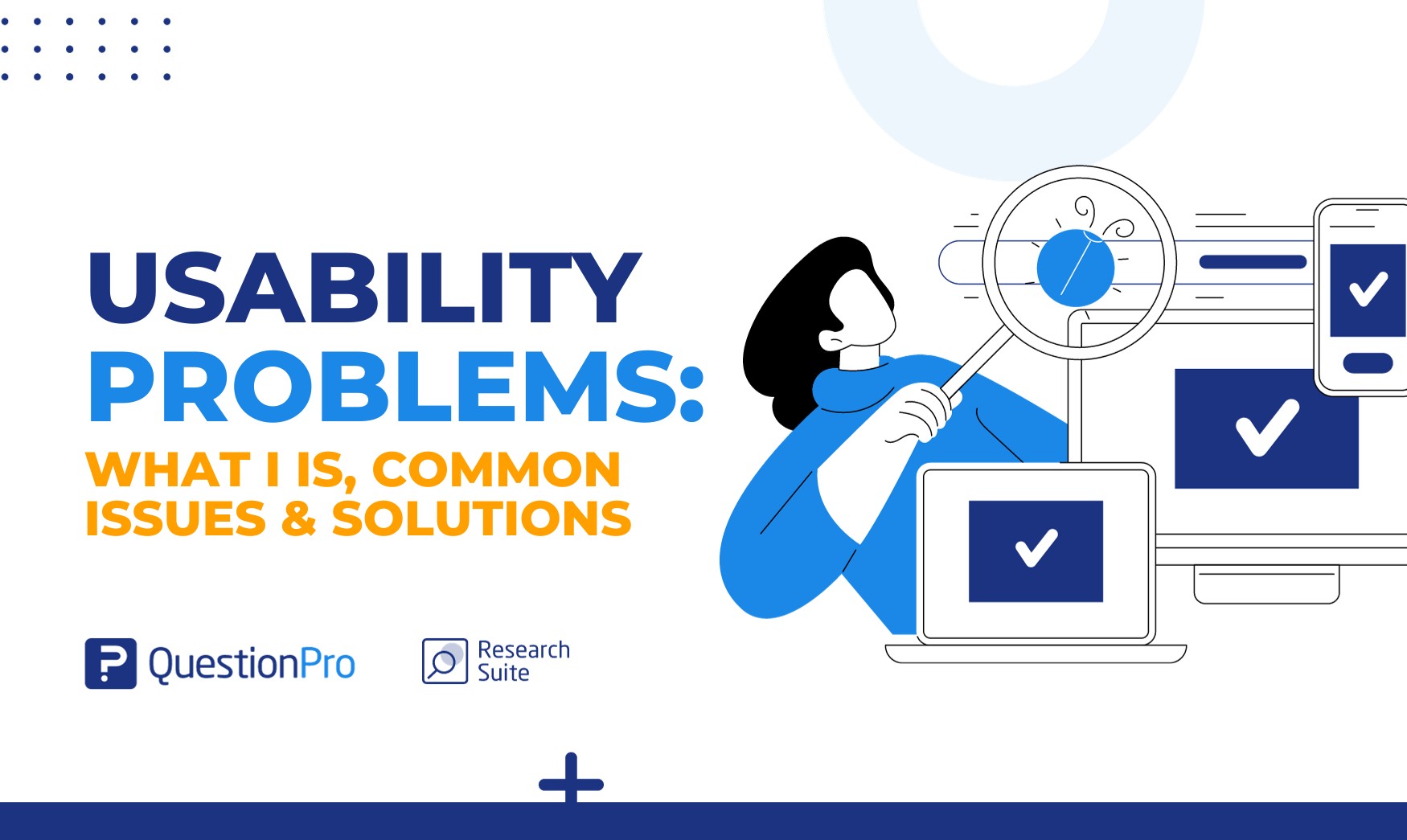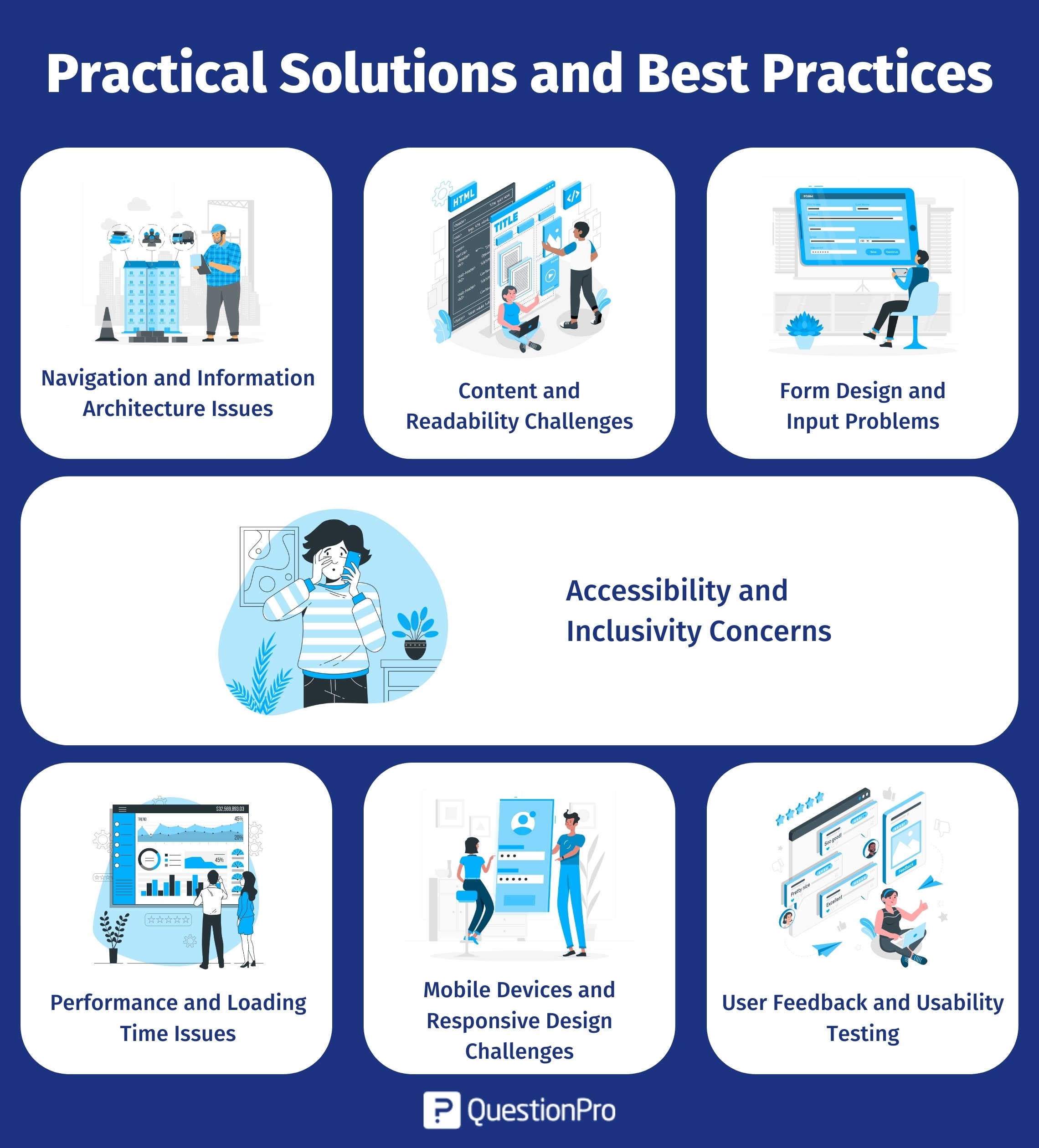
Usability problems are a significant concern in the world of design and technology. Whether you’re developing a website, a mobile device app, or a physical product, ensuring a high level of usability is essential for user satisfaction and success.
In this blog, we will explore usability problems, delve into some common issues plaguing user experiences, and offer practical solutions to address these challenges.
What Is Usability?
Usability refers to the ease users can interact with and navigate through a product, system, or interface. A usable design ensures that users can achieve their goals efficiently and effectively while enjoying a positive experience.
Usability is a multidimensional concept encompassing learning, efficiency, memorability, errors, user interactions, and user satisfaction.
What Are Usability Problems?
Usability problems refer to user issues or difficulties when interacting with a product, system, or interface. These problems can make it challenging for users to accomplish their tasks efficiently and effectively.
Usability issues can arise in various contexts, including software applications, websites, physical devices, and other user-facing technology.
Common Usability Problems
Common usability problems encompass many issues that users often encounter when interacting with products, websites, software, or systems. Identifying and addressing these problems is essential for creating user-friendly and efficient experiences. Here are some of the most common usability issues:
One of the most common usability issues is complex navigation. Users get frustrated when they need help finding what they need easily. This problem often arises from a cluttered user interface design, poor information architecture, or a need for clear pathways.
Solution: Simplify the navigation site structure, use intuitive labels, and conduct user testing to ensure users can find what they’re looking for quickly.
2. Slow Load Times
Slow-loading websites or applications can result in high bounce rates and negative user experiences. Users expect a seamless, swift experience, and when a product is sluggish, it can lead to frustration and abandonment.
Solution: Optimize your code, use efficient hosting services, and compress media files to improve load times. Regularly monitor website usability performance and make necessary adjustments.
3. Inconsistent Design
Inconsistencies in design elements, such as colors, fonts, and buttons, can confuse users and make your product unprofessional.
Solution: Create a design style guide and stick to it throughout your project. Consistency not only improves usability but also strengthens brand identity.
4. Overwhelming Content
Too much information or overcrowded screens overwhelm potential users. They might miss essential details or become disinterested.
Solution: Prioritize content, maintain a clean and organized layout, and provide clear calls to action to guide users through the content.
5. Inadequate Feedback
Users need feedback when they perform actions, whether submitting a form, clicking a button, or selecting. Without feedback, they might question whether their actions had any effect.
Solution: Provide visual and auditory feedback for user actions. For example, display confirmation messages or change button states when users click them.
6. Accessibility Issues
Failing to make your product accessible to all users, including those with disabilities, is a significant usability problem.
Solution: Follow accessibility guidelines (e.g., WCAG) to ensure your product is usable by everyone. This includes providing alt text for images, keyboard navigation, and semantic HTML.
Practical Solutions and Best Practices
Here are practical solutions and best practices for addressing usability issues and enhancing your user’s experience on websites and applications:

- Simplify Menu Structures: Create clear, intuitive menus with well-defined categories and labels.
- Improve Search Functionality: Implement a robust search feature with filters and suggestions to help users find content easily.
2. Content and Readability Challenges
- Use Plain Language: Write in plain, clear, and concise language to cater to a broader audience.
- Enhance Readability: Select legible fonts, maintain adequate spacing, and ensure high contrast between text and background.
3. Form Design and Input Problems
- Optimize Form Length: Minimize the number of form fields and only request essential information.
- Provide Clear Error Messages: Inform users of errors promptly and offer guidance on correcting the error message.
4. Accessibility and Inclusivity Concerns
- Adhere to Web Content Accessibility Guidelines (WCAG): Implement accessible design practices, including alternative text for images, keyboard navigation, and clear document structure.
- Test with Assistive Technologies: Utilize screen readers, voice recognition software, and other assistive technologies to identify and address accessibility barriers.
5. Performance and Loading Time Issues
- Optimize Media: Compress and properly format images and videos to reduce loading times.
- Minimize HTTP Requests: Reduce the number of external resources and scripts on your pages.
6. Mobile Devices and Responsive Design Challenges
- Implement Responsive Design: Ensure your website or application adapts to various screen sizes and orientations.
- Prioritize Mobile Optimization: Optimize performance and user-centered design specifically for mobile users.
7. User Feedback and Usability Testing
- Gather User Feedback: Encourage users to provide feedback through surveys, comments, and ratings.
- Conduct Usability Tests: Regularly test your product with real users to identify issues and validate improvements.
How QuestionPro Research Suit Can Help With Usability Problems?
QuestionPro Research Suite is a comprehensive platform designed to help with various survey research and data collection aspects. While it may not be a dedicated usability testing tool like some other software, it can still be used to gather valuable data and insights related to usability issues.
Here’s how QuestionPro Research Suite can help with usability issues:
- Surveys and Questionnaires: QuestionPro allows you to create surveys and questionnaires that can be distributed to users or participants to gather feedback on the usability of web pages, applications, or products. You can design questions specifically focused on usability issues, such as ease of navigation, clarity of content, or overall user satisfaction.
- Feedback Collection: The platform provides various question types and response formats, including multiple-choice questions, Likert scales, and open-ended text fields. This flexibility enables you to collect specific feedback about usability issues or general user impressions.
- User Testing: You can use QuestionPro to set up usability test scenarios and tasks. Participants can complete these tasks and provide feedback on their experiences, highlighting any usability issue they encounter.
- Targeted Audiences: QuestionPro allows you to target specific user groups or demographics for your research, which is important when investigating usability problems because different user segments may encounter different issues.
- Data Analysis: The platform offers data analysis and reporting tools, making identifying trends and patterns in your collected feedback easier. This can help you pinpoint common usability issues and prioritize areas for improvement.
- Collaboration: Collaborative features in QuestionPro allow multiple team members to work on a usability research project, making it easier to manage and analyze data collectively.
- Integration: QuestionPro can integrate with other tools and platforms, which can be useful for incorporating usability testing results into your broader user research and product development processes.
Conclusion
Usability problems can significantly impact the success of your product or website. You can create a more user-friendly and successful design by understanding usability, identifying common issues, and implementing practical solutions.
Usability should be an ongoing consideration, and regular testing and improvement are key to maintaining a positive user experience.
QuestionPro Research Suite is a versatile tool for addressing usability issues by facilitating the collection of valuable user feedback and data collection. Its survey and feedback capabilities enable organizations to identify and prioritize and identify usability issues, ultimately contributing to enhanced user experiences and product improvements.







